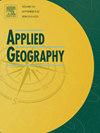Urbanization-driven and intercity interaction-induced warming effects in the Beijing-Tianjin-Hebei urban agglomeration: A comparison of heatwave and non-heatwave scenarios
IF 4
2区 地球科学
Q1 GEOGRAPHY
引用次数: 0
Abstract
Urbanization-driven land use and cover change exacerbates urban warming and amplifies the effects of global climate change, particularly in interconnected urban agglomerations. This study utilized the Weather Research and Forecasting (WRF) model coupled with an Urban Canopy Model (UCM) to investigate how urbanization and intercity interactions influence urban warming during the summer season in the Beijing-Tianjin-Hebei (BTH) urban agglomeration, with a specific emphasis on whether the warming effect of urbanization exacerbates under heatwave scenarios. The results showed that from 2010 to 2020, the expansion of urban areas in the BTH urban agglomeration from 2259.81 to 3964.80 km2 led to a 0.406 °C increase in 2-m temperatures (T2) in typical summer. Heatwave further exacerbated the warming effects in the urban agglomeration, with T2 rising by 0.648 °C during heatwave periods compared to 0.308 °C during non-heatwave periods. Major cities like Beijing and Tianjin significantly contributed to the warming of the entire urban agglomeration and other specific cities during heatwave periods. These findings underscore the need for collaborative urban planning to mitigate heat-related risks and manage compounded effects of urbanization and heatwave.
京津冀城市群城市化驱动与城际互动增温效应:热浪与非热浪情景比较
城市化驱动的土地利用和覆盖变化加剧了城市变暖,放大了全球气候变化的影响,尤其是在相互关联的城市群中。利用天气研究与预报(WRF)模型和城市冠层模型(UCM),研究了京津冀城市群夏季城市化和城际相互作用对城市增温的影响,重点研究了热浪情景下城市化增温效应是否加剧。结果表明:2010 - 2020年,京津冀城市群城市面积从2259.81 km2扩大至3964.80 km2,导致典型夏季2 m温度(T2)升高0.406℃;热浪进一步加剧了城市群的增温效应,热浪期T2升高0.648℃,非热浪期T2升高0.308℃。北京和天津等主要城市对整个城市群和其他特定城市在热浪期间的变暖有显著贡献。这些发现强调了协同城市规划的必要性,以减轻与热有关的风险,并管理城市化和热浪的复合影响。
本文章由计算机程序翻译,如有差异,请以英文原文为准。
求助全文
约1分钟内获得全文
求助全文
来源期刊

Applied Geography
GEOGRAPHY-
CiteScore
8.00
自引率
2.00%
发文量
134
期刊介绍:
Applied Geography is a journal devoted to the publication of research which utilizes geographic approaches (human, physical, nature-society and GIScience) to resolve human problems that have a spatial dimension. These problems may be related to the assessment, management and allocation of the world physical and/or human resources. The underlying rationale of the journal is that only through a clear understanding of the relevant societal, physical, and coupled natural-humans systems can we resolve such problems. Papers are invited on any theme involving the application of geographical theory and methodology in the resolution of human problems.
 求助内容:
求助内容: 应助结果提醒方式:
应助结果提醒方式:


